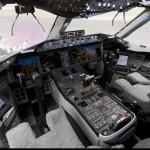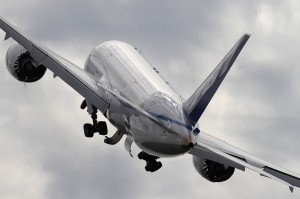 The 787 is coming to the east coast of Australia next weekend. While Qantas will be making the most of the flying visit, Virgin Australia will be visiting Boeing’s impressive new aircraft as well.
The 787 is coming to the east coast of Australia next weekend. While Qantas will be making the most of the flying visit, Virgin Australia will be visiting Boeing’s impressive new aircraft as well.
I’m planning to pop up to Melbourne and see the plane – I’m waiting to see if there’s any spaces in the list Virgin Australia is defining of who from our organisation will get to go see the aircraft.
Marty in the other hand, is going for a fly in it. More on that later.
I was sent this recently – it’s an interesting insight into the aircraft from a senior pilot converting across from the 767. I can’t swear to the accuracy of the following, but it makes interesting reading all the same.
- A computer nerd would describe the 787 as 17 computer servers packaged in a Kevlar frame. The central brain is the Common Core System (CCS). Two Common Computing Resources (CCRs) coordinate the communications of all the computer systems, isolating faults and covering failed systems with working systems. When battery power is first applied to the airplane in the morning, it takes about 50 seconds for the L CCR to boot up. After this, a few displays light up and you can start the APU. If there is a major loss of cockpit displays, this may require a CCR reboot, which would take about a minute.
- The 787 has four times the potential electric generation of the 777 – 1.4 gigawatts. It only took Dr. Emmett Brown only 1.21 gigawatts to move Marty McFly through time … The generators produce 235 VAC for the large users on the bus – otherwise the traditional 115 VAC and 28 VDC are there. Seventeen Remote Power Distribution Units (RPDU) power about 900 loads through the plane. The power distribution system is in the aft belly along with the Power Electronics Cooling System (PECS). It’s liquid cooling for the large motors, along with an Integrated Cooling System (ICS) for use by the galley carts and cabin air – and IFE.
- If 3 of the 4 engine drive generators fail, the APU starts. Two APU generators can be operated to the certified ceiling of FL430. Lose all 4 generators and Ram Air Turbine (TA) deploys to power essential buses and if necessary hydraulic power to the flight controls. Even if the RAT fails, standby power the autopilot and captain’s flight director and instruments, FMC, 2 IRSs, VHF radios, etc. But if you’re down to battery only, time is limited. Brakes and Antiskid are electric – 28 volts – so even on standby power you have brakes and antiskid.
- Flight Controls are hydraulic with a few exceptions. Engine drive and Electric pumps operate at 5,000 psi to allow for smaller tubing and actuators (saving weight). The loss of all three systems, two spoiler panels on each wing are electrically powered all the time, as is stabilizer trim. No Flaps – but you can still fly the plane. The loss of Hydraulics and Electrics result in power from Permanent Magnetic Generators (PMG’s) which produce power even if the engine is wind milling. PMG’s failed – flight controls are powered by the 28 volt standby bus.
 The majority of circuit breakers are “virtual” and if necessary can be reset through the circuit breaker indication and control display on an MFD. Actual “thermal” circuit breakers can’t be reset.
The majority of circuit breakers are “virtual” and if necessary can be reset through the circuit breaker indication and control display on an MFD. Actual “thermal” circuit breakers can’t be reset.- Loss of the Attitude and Heading Reference units (AHRU’s) and reversion to standby instruments – displayed on the normal PFD’s.
- Loss of all three pitot/static systems or air data computers and the aircraft reverts to angle of attack converted to speed – displayed on the normal PFD’s airspeed tape. GPS altitude is substituted for air data altitude – and also displayed on the PFD.
- Loss of the inertial reference units defaults to GPS positioning. The IRS’s can even be aligned airborne from the GPS, iv available.
- There isn’t a pneumatic system as such. Engine Bleed is used for anti ice only. Wing anti ice is electric.
- The two air-conditioning packs control two electric cabin air compressors (CAC). The four CAC’s share two inlets under the aircraft. If a Pack controller fails, the remaining pack controller takes over all four CACs.
- Differential pressure is increased to 9.4 PSI, giving a 6,000 ft cabin altitude at FL430. Cabin air humidity is automatic, with a flight deck humidifier. Cabin windows are larger with 5 levels of electric shading from clear to black.
- The APU shuts down automatically in the event of an APU fire – airborne or on the ground. Cargo Fire also results in automatic fire extinguisher discharge.
- Like the 777 – a nitrogen gas generation system pressurises the fuel tanks to displace fumes and provide full time flammable protection.
- CPDLC is installed in overdrive. Uplinked speed, heading, altitude display on a second line on the MCP and can be transferred into the actual speed, heading and altitude control. Even conditional clearances can be uplinked, accepted and action by the pilot and FMC.
- There’s an auto drag feature that operates when the aircraft is high on approach and landing flaps have been selected. Ailerons and the two most outboard spoilers are extended, while maintaining airspeed, to assist in glide path capture from above.
- Flaps, Ailerons, Flaperons and Spoilers are symmetrically moved in cruise based on airspeed, weight and altitude to optimise cruise performance to alter camber to reduce drag.
- Fuel Jettison is installed but an automatic Fuel Balancing system is also installed. No more opening crossfeed valves – or forgetting to close them.
- Gust suppression is enhanced to symmetrically deflect the flaperons, ailerons and elevators to smooth the ride in turbulence. There’s a lateral component as well, enacted through the rudder on approach in response to gusts and turbulence.
- The aircraft is approved for ILS using GPS and a ground based augmentation system (GBAS) with conventional Cat 1 minima. HUD approaches will allow lower minimums augmenting vision at approved airports with runway centerline guidance from either ILS or GPS.
- The CDU’s are virtual – and can be moved from one MFD to another. Lots of shortcuts and customisation is built into the handling mechanism in the MFD controls
If I do head out to seethe 787 – or get to go for ride in it – I’ll write about it here.
